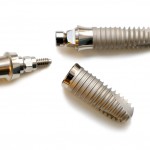
The authors of this systematic review wished to investigate the survival rate of dental implant placement in sites where the previous implant had failed. Implant failure has been categorised as early failure prior to abutment connection possibly due to poor wound healing, and late failures that occurred after occlusal loading to biomechanical problems or peri-implantitis. By studying the survival rate of the replacement implants they hoped to determine which factors (operator or patient) might affect outcome.
Methods
The research question based on a PICO framework was:
‘In partially edentulous individuals, what is the survival rate of implants replacing a previously failed original implant?’
The secondary outcome was the survival rate of replacement implants with respect to implant surface (smooth vs rough) and implant site (anterior vs posterior).
The authors searched the electronic databases OVID Medline, EMBASE, and SCOPUS using the following MeSH terms: ‘dental implants’, ‘dental implantation’, or ‘dental restoration failure’, combined with ‘retreatment’, ‘replacement’, or ‘reoperation’. The search was limited to the English language and spanned the years 1991 to 2018.
Two reviewers independently, selected studies, extracted data and assessed risk of bias (RoB) using the Newcastle-Ottawa scale (NOS).
Results
- 8 retrospective clinical cohort studies met the inclusion criteria.
- The quality assessment using the NOS was judged as moderate risk of bias.
- Overall, higher success rates of implant retreatment (93% to 96%) were reported in the later studies than in the earlier studies (71% to 88%).
- This systematic review found a weighted mean survival rate of 86.3% for implant retreatments over a time range less than 1 year to over 5 years
- Retreatments with rough-surface implants exhibited ‘4-times greater’ survival than smooth-surface implants (odds ratio 3.7 [95% CI:1.5 to 9]).
- No significant difference was found in the pooled retreatment survival of implants placed in the anterior versus posterior sextants
Conclusion
The authors concluded: –
Based on the findings of this systematic review, the following conclusions were drawn:
- A comparatively high survival rate of 86.3% for implant retreatments was observed with follow-up ranging from less than 1 year to over 5 years.
- Higher survival rates in retreatment were reported with rough-surfaced implants than with smooth surfaced implants.
- The relatively high overall implant survival rate after retreatment suggests that most initial implant failures are likely attributable to modifiable risk factors, such as implant architecture, anatomic site, infection, or occlusal overload.’
Comments
Overall this review tries to combine a small number of studies to create a seemingly large positive result on the survival rate of implants in previously failed surgical sites. Their conclusions need to be analysed with extreme caution for the following reasons:
No preregistration of the systematic review (PROSPERO)
or use of a study framework (PRISMA).
- This is an important omission. These protocols help to assure that decisions made during the research process aren’t arbitrary and reduces biases.
- The search strategy was adequate but would have benefitted from unrestricted language and searching the grey literature.
- The authors used the Newcastle-Ottawa score stating that risk of bias was moderate across the studies. I would argue that as there are no comparator or control groups the studies are not true cohort studies. Taking this into account and using a more appropriate RoB model such as Hoy these studies would be downgraded to high risk of bias.
- There is so much heterogeneity in these studies that are no reliable conclusions to be made by synthesising the data, the author would have been better served restricting themselves to a narrative review.
- Authors need to avoid the use of odds ratio to express summary estimates that do not relate to case control studies. Risk difference and risk ratio are easier to interpret accurately.
- Due to the heterogeneity of the studies the pooled mean survival rate of 86.3% ranged over a vague time period which was impossible to interpret and made little arithmetic sense.
- The comparison of machined vs roughened surfaces is interesting but historical in nature as machined surface implants have not been used routinely in clinical practice for almost 20 years
- The conclusions fall foul of the ‘base rate fallacy’ . It would appear from the data in Chrcanovic’s study that only 23% of failed implants sites were suitable for replacement surgery which may introduce selection bias into any results.
Links
Primary paper
Oh, S.L., Shiau, H.J. & Reynolds, M.A. (2019) Survival of dental implants at sites after implant failure: A systematic review. Journal of Prosthetic Dentistry. [Online] 1–7. Available from: doi:10.1016/j.prosdent.2018.11.007.
Other references
Hoy, D., Brooks, P., Woolf, A., Blyth, F., et al. (2012) Assessing risk of bias in prevalence studies: Modification of an existing tool and evidence of interrater agreement. Journal of Clinical Epidemiology. [Online] 65 (9), 934–939. Available from: doi:10.1016/j.jclinepi.2011.11.014.
Holcomb, W.L., Chaiworapongsa, T., Luke, D.A. & Burgdorf, K.D. (2001) An Odd Measure of Risk. Obstetrics & Gynecology. [Online] 98 (4), 685–688. Available from: doi:10.1097/00006250-200110000-00028.
Chrcanovic, B.R., Kisch, J., Albrektsson, T. & Wennerberg, A. (2017) Survival of dental implants placed in sites of previously failed implants. Clinical Oral Implants Research. [Online] 28 (11), 1348–1353. Available from: doi:10.1111/clr.12992.
